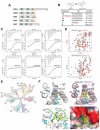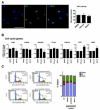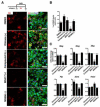Selective chemical modulation of gene transcription favors oligodendrocyte lineage progression
- PMID: 24954007
- PMCID: PMC4104156
- DOI: 10.1016/j.chembiol.2014.05.009
Selective chemical modulation of gene transcription favors oligodendrocyte lineage progression
Abstract
Lysine acetylation regulates gene expression through modulating protein-protein interactions in chromatin. Chemical inhibition of acetyl-lysine binding bromodomains of the major chromatin regulators BET (bromodomain and extraterminal domain) proteins has been shown to effectively block cell proliferation in cancer and inflammation. However, whether selective inhibition of individual BET bromodomains has distinctive functional consequences remains only partially understood. In this study, we show that selective chemical inhibition of the first bromodomain of BET proteins using our small-molecule inhibitor, Olinone, accelerated the progression of mouse primary oligodendrocyte progenitors toward differentiation, whereas inhibition of both bromodomains of BET proteins hindered differentiation. This effect was target specific, as it was not detected in cells treated with inactive analogs and independent of any effect on proliferation. Therefore, selective chemical modulation of individual bromodomains, rather than use of broad-based inhibitors, may enhance regenerative strategies in disorders characterized by myelin loss such as aging and neurodegeneration.
Copyright © 2014 Elsevier Ltd. All rights reserved.
Figures






Comment in
-
Nonequivalent response to bromodomain-targeting BET inhibitors in oligodendrocyte cell fate decision.Chem Biol. 2014 Jul 17;21(7):804-6. doi: 10.1016/j.chembiol.2014.07.003. Chem Biol. 2014. PMID: 25036774 Free PMC article.
Similar articles
-
Nonequivalent response to bromodomain-targeting BET inhibitors in oligodendrocyte cell fate decision.Chem Biol. 2014 Jul 17;21(7):804-6. doi: 10.1016/j.chembiol.2014.07.003. Chem Biol. 2014. PMID: 25036774 Free PMC article.
-
Potent and selective bivalent inhibitors of BET bromodomains.Nat Chem Biol. 2016 Dec;12(12):1097-1104. doi: 10.1038/nchembio.2210. Epub 2016 Oct 24. Nat Chem Biol. 2016. PMID: 27775716
-
Disrupting Acetyl-Lysine Recognition: Progress in the Development of Bromodomain Inhibitors.J Med Chem. 2016 Feb 25;59(4):1271-98. doi: 10.1021/acs.jmedchem.5b01514. Epub 2015 Dec 1. J Med Chem. 2016. PMID: 26572217
-
The bromodomain: from epigenome reader to druggable target.Biochim Biophys Acta. 2014 Aug;1839(8):676-85. doi: 10.1016/j.bbagrm.2014.03.011. Epub 2014 Mar 28. Biochim Biophys Acta. 2014. PMID: 24686119 Free PMC article. Review.
-
Small molecule inhibitors of bromodomain-acetyl-lysine interactions.ACS Chem Biol. 2015 Jan 16;10(1):22-39. doi: 10.1021/cb500996u. ACS Chem Biol. 2015. PMID: 25549280 Review.
Cited by
-
Structure-Guided Design of a Domain-Selective Bromodomain and Extra Terminal N-Terminal Bromodomain Chemical Probe.J Med Chem. 2023 Dec 14;66(23):15728-15749. doi: 10.1021/acs.jmedchem.3c00906. Epub 2023 Nov 15. J Med Chem. 2023. PMID: 37967462 Free PMC article.
-
Interplay between transcriptional control and chromatin regulation in the oligodendrocyte lineage.Glia. 2015 Aug;63(8):1357-75. doi: 10.1002/glia.22818. Epub 2015 May 12. Glia. 2015. PMID: 25970296 Free PMC article. Review.
-
A hierarchical and collaborative BRD4/CEBPD partnership governs vascular smooth muscle cell inflammation.Mol Ther Methods Clin Dev. 2021 Feb 27;21:54-66. doi: 10.1016/j.omtm.2021.02.021. eCollection 2021 Jun 11. Mol Ther Methods Clin Dev. 2021. PMID: 33768129 Free PMC article.
-
Binding selectivity of inhibitors toward the first over the second bromodomain of BRD4: theoretical insights from free energy calculations and multiple short molecular dynamics simulations.RSC Adv. 2020 Dec 24;11(2):745-759. doi: 10.1039/d0ra09469b. eCollection 2020 Dec 24. RSC Adv. 2020. PMID: 35423696 Free PMC article.
-
BET proteins: Investigating BRDT as a potential target for male contraception.Bioorg Med Chem Lett. 2020 Mar 15;30(6):126958. doi: 10.1016/j.bmcl.2020.126958. Epub 2020 Jan 21. Bioorg Med Chem Lett. 2020. PMID: 32019712 Free PMC article. Review.
References
-
- Coldham I, Dobson BC, Fletcher SR, Franklin AI. Intramolecular Diploar Cycloaddition Reactions to Give Substituted Indoles - A Formal Synthesis of Deethylibophyllidine. Eur J Org Chem. 2007:2676–2686.
Publication types
MeSH terms
Substances
Associated data
- Actions
- Actions
Grants and funding
- R37NS42925/NS/NINDS NIH HHS/United States
- R01 CA087658/CA/NCI NIH HHS/United States
- R01CA87658/CA/NCI NIH HHS/United States
- R01HG004508/HG/NHGRI NIH HHS/United States
- R01 NS052738/NS/NINDS NIH HHS/United States
- R03NS072578/NS/NINDS NIH HHS/United States
- R01 HG004508/HG/NHGRI NIH HHS/United States
- UL1 RR029887/RR/NCRR NIH HHS/United States
- R01 NS042925/NS/NINDS NIH HHS/United States
- R03 NS072578/NS/NINDS NIH HHS/United States
- R37 NS042925/NS/NINDS NIH HHS/United States
- R01-NS52738/NS/NINDS NIH HHS/United States
- UL1RR029887/RR/NCRR NIH HHS/United States
LinkOut - more resources
Full Text Sources
Other Literature Sources

